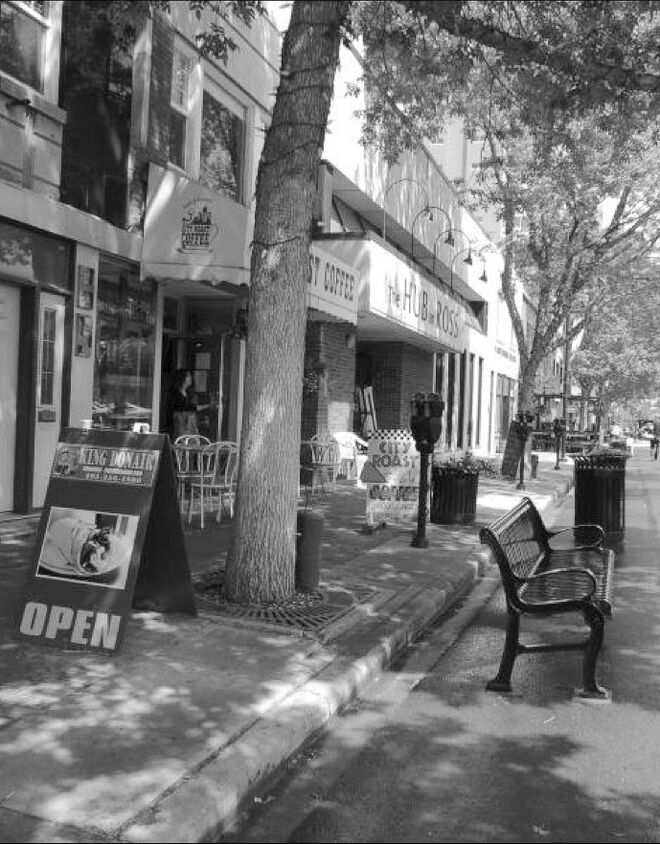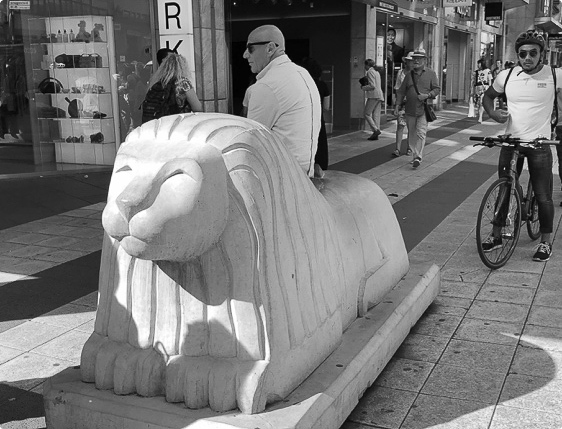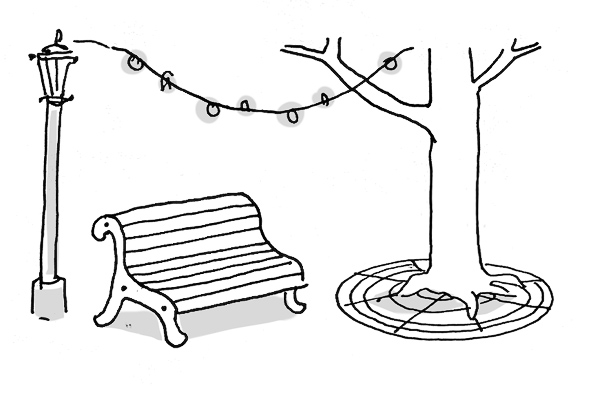8.4. Street Furnishings
Aus Pattern Language Wiki
A Street As Room needs the what a room has, including seating, tables, decorative furnishings, Movable Seating, and other elements.
Problem-statement: People need furnishings on streets in order to be comfortable, to have places to sit, to chat, to be protected, and to watch other people go by. But there are a number of challenges.
Discussion: We have already discussed the advantages of Movable Seating in public spaces, but also their challenges for theft. The solution is that they can either be tethered down with secure chains, or removed and stored by adjacent businesses or agencies.
There are many other elements that can make a streetscape more active and appealing. Among them are protective bollards, fencing, planters, lamps, string lights, signs, banners, flags, and of course, works of art. In fact any of these elements can itself be a work of art — like the pedestrian barriers in Stockholm that are lion sculptures, symbolizing the Swedish coat of arms.
In addition to being secure, these and other street furnishings also need to be durable and resistant to moisture and damage.
Therefore:
Develop street furnishings for streets, just as you would for rooms in a house. Take care to secure them, and select them for their durability, water resistance, and beauty.
Remember to place the furnishings in groups, not in endless repetitive rows — Small Groups Of Elements. Use Construction Ornament and Human-Scale Detail…
¹ There are a number of publications with more information on street furniture and its placement — see for example Yücel, G. F. (2013). Street furniture and amenities: Designing the user-oriented urban landscape. In Advances in Landscape Architecture. DOI: 10.5772/55770
Mehaffy, M. et al. (2020). STREET FURNISHINGS (pattern). In A New Pattern Language for Growing Regions. The Dalles: Sustasis Press. Available at https://pattern-language.wiki/.../Street_Furnishings
SECTION I:
PATTERNS OF SCALE
1. REGIONAL PATTERNS
Define the large-scale spatial organization…
1.4. 400M THROUGH STREET NETWORK
2. URBAN PATTERNS
Establish essential urban characteristics…
3. STREET PATTERNS
Identify and allocate street types…
4. NEIGHBORHOOD PATTERNS
Define neighborhood-scale elements…
5. SPECIAL USE PATTERNS
Integrate unique urban elements with care…
6. PUBLIC SPACE PATTERNS
Establish the character of the crucial public realm…
7. BLOCK AND PLOT PATTERNS
Lay out the detailed structure of property lines…
8. STREETSCAPE PATTERNS
Configure the street as a welcoming place…
9. BUILDING PATTERNS
Lay out appropriate urban buildings…
10. BUILDING EDGE PATTERNS
Create interior and exterior connectivity…
10.1. INDOOR-OUTDOOR AMBIGUITY
SECTION II:
PATTERNS OF MULTIPLE SCALE
11. GEOMETRIC PATTERNS
Build in coherent geometries at all scales…
11.2. SMALL GROUPS OF ELEMENTS
12. AFFORDANCE PATTERNS
Build in user capacity to shape the environment…
13. RETROFIT PATTERNS
Revitalize and improve existing urban assets …
14. INFORMAL GROWTH PATTERNS
Accommodate “bottom-up” urban growth…
15. CONSTRUCTION PATTERNS
Use the building process to enrich the result…
SECTION III:
PATTERNS OF PROCESS
16. IMPLEMENTATION TOOL PATTERNS
Use tools to achieve successful results…
16.2. ENTITLEMENT STREAMLINING
16.3. NEIGHBORHOOD PLANNING CENTER
17. PROJECT ECONOMICS PATTERNS
Create flows of money that support urban quality…
17.4. ECONOMIES OF PLACE AND DIFFERENTIATION
18. PLACE GOVERNANCE PATTERNS
Processes for making and managing places…
18.3. PUBLIC-PRIVATE PLACE MANAGEMENT
19. AFFORDABILITY PATTERNS
Build in affordability for all incomes…
19.1. INTEGRATED AFFORDABILITY
20. NEW TECHNOLOGY PATTERNS
Integrate new systems without damaging old ones…
20.2. RESPONSIVE TRANSPORTATION NETWORK COMPANY


